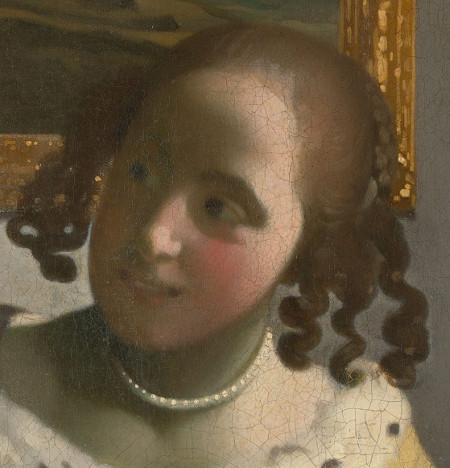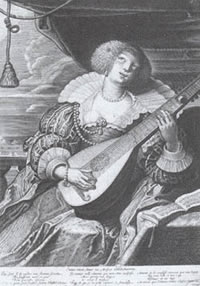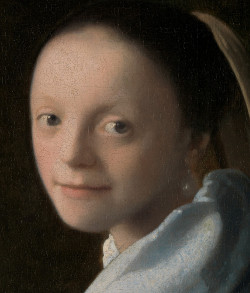The Guitar Player
c. 1670–1673Oil on canvas
53 x 46.3 cm. (20 7/8 x 18 1/4 in.)
Iveagh Bequest, London
The Guitar Player is one of the most beautiful examples of Vermeer's late style. The crispness of his image and the radiant colors give the painting a glowing quality. Vermeer, in his paintings of the 1670s, was no longer concerned with describing specific textures of materials. Brushstrokes became freer and more expressive than in his earlier works as he emphasized patterns of color rather than textures. Vermeer modeled the girl's dress and jacket, for example, with sharply defined planes of color, The subtle modulations in folds and contours that he formerly created by applying glazes over opaque paints are no longer evident.

Johannes Vermeer
c. 1670 –1673
Oil on canvas
53 x 46.3 cm.
Kenwood House, Iveagh Bequest, London
The face also is treated differently (fig. 1). Its expression is outward and not self-contained. The nuances of shading that suggested qualities of character and personality have been replaced by distinctly separate areas of light, and shade. The interest in pattern is evident in the ringlets of hair silhouetted against the wall.
In addition to the changed emphasis of his painting technique, Vermeer also built this composition on a different principle. As in he drew the focus of his composition away from the center of the painting. The girl is placed so far to the left that her arm is cut by the edge. Light falls to the left and a landscape hangs behind the girl on the back wall. The off-center composition is further emphasized by the direction of the girl's glance. Vermeer probably was reacting against the balanced, contained quality of his earlier work.
One might suspect that a pendant existed which would have balanced this painting, but a document seems to provide evidence to the contrary. In January, 1676, slightly more than a month after Vermeer's death, his widow, Catharina Bolnes, appeared before the notary in Delft to settle a debt of 617 guilders and 6 stuivers with Hendrick van Buyten, master baker in the town. On that occasion she sold two paintings to him, one representing "two persons one of whom is writing a letter and the other with a person playing a guitar." One of the paintings involved in this revealing document is the Lady Writing a Letter with Her Maid; the other is probably The Guitar Player. Vermeer's widow almost certainly would not have separated The Guitar Player from a pendant if one had existed.

Elise Goodman
"The Landscape on the Wall of Vermeer"The Cambridge Companion to Vermeer (Cambridge Companions to the History of Art)
Cambridge,
2001, pp. 81–82
The Guitar Player also recalls French engravings of modes and manners of the 1630s that depict a lutenist in front of a garden, field, or park. Two examples of the genre are an anonymous printof 1630 and another entitled Omnia vincit Amor nec Musica vincit Amorem (Love Conquers All but Music Does Not Conquer Love) (fig. 2), designed by the expatriot Fleming Pieter van Moi (1599–1650), engraved by the popular French master Charles David (c. 1600–1636), and published by the prolific Jean Ier Leblond. The Omnia vincit Amor (Love Conquers All) recalls particularly Vermeer's composition: both open-mouthed musicians are placed on a diagonal in the foreground of a shallow space; they are flanked by a table with a book or books. In the French engraving, this space is a balcony separated from the garden and landscape by a drapery, while in the Vermeer, the area is a room with a curtain at the right. With consummate skill, Vermeer distilled the landscape into the painting hung deliberately and directly behind the musician's head; he related it visually to and made it reflect her beauty. The landscape seems lovingly to continue and recapitulate her brown hair: the rightward tilt of her head and her ringlets are suggestively relate in the arching foliate branches of the tree above her. Lawrence Gowing puts it, "her bell-like shape is compared with the round head of a tree against sky, painted in the style of Wynants behind her." Her music weaves, as it were, a civilizing magic into plain and forest. She may be thought to recall a beautiful guitarist named Uranie in an air for guitar entablature of 1629, whose "divine voice animates these fields and these woods." The Baroque guitar head by Vermeer's musician is a piece of fashionable accoutrement for this purpose in the later seventeenth century it was rapidity supplanting the lute as the most popular solo instrument to accompany a singer.
The general subject of The Guitar Player is also purified in Jouissance (PIeasurabIe), Countryhouse, and Promenade lyrics of the period, in which poets delicately intertwined the woman with features of her natural environment, thereby heightening her attractiveness and intimating that she reflects and even produces the beauty of the landscape. At times she turns into a metaphorical tree or a verdant meadow. This metamorphosis was popular in English and French literature of the sixteenth and the seventeenth centuries. It also appeared in the Dutch poems and songs of Hooft, Huygens, and Vondel, ail of whom lived abroad and were greatly influenced by European literary trends. In a spirit similar to Vermeer, Nicholas Hookes in 1653 poeticized the effects of his Amanda's beauty on the tree under which she sits: "The broad- leav'd Sycomore, and ev'ry tree / Shakes like the trembling Aspe, and bends to thee, / And each leaf proudly strives with fresher air/ To fan the curled tresses of thy hair."

Musica vincit Amorem
Pieter van Mol, Charles David and
Jean Ier Lebond
Paris, Bibliothèque Nationale,
Département des Estampes
In fact, female arborescence, as we may call it, was an imitational convention of the period and appeared in several courtesy books. It is discussed in André du Chesne's Figures mystiques du riche et precieux cabinet des dames (Mystical Figures of the Rich and Precious Cabinet of Ladies, Paris, 1605). Here woman is the epitome of nature, metaphorized as the Tree of Life that assimilates all the perfections and virtues of the other plants. The sweetest charms of earthly lave find refuge under the shady foliage of her womanhood Jacques Corbin's panegyric La royne Marguerite (Queen Margaret) asserts hyperbolically in the tradition of the biblical book the Song of Solomon that the lady is higher than an alder tree, more noble than an apple tree, and lovelier to behold than the highest pIane tree. Abraham Darcie, in his Honour of Ladies (London, 1622), generalizes that the comeliness of women "remains as a Character and patterne, which makes it exteriorly known, as the beauty of blossomes of Trees bear witness of the Goodness of the fruit which grows thereof."
The ubiquitous idea that the lady was the "masterpiece of nature," to be admired, possessed, and displayed, appeared in countless poems, songs, and tracts on beautiful women in the seventeenth century. From the Chevalier de l'Escale's Le champion desfemmes (The Champion of Women) through the Sieur de Saint-Gabriel's Le mérite des dames (The Merit of Ladies) to Constantijn Huygens's "Sur le portraict" (On the Portrait; 1673), the ideal woman was variously labeled the masterpiece and miracle of nature and the ornament of the earth.
The yellow-jacketed girl playing the guitar or cittern in the Kenwood picture (fig. 4) also has the characteristic jaw formation of the Wrightsman portrait (fig. 3). Assuming the date assigned to that picture (1671–1672) is about right, it could represent Maria (Vermeer's youngest daughter) at the age of seventeen or eighteen. Elisabeth, born about 1657, is a less likely candidate since she was probably less than fifteen years old at the time the Kenwood picture was painted.
All this, unfortunately, is tantalizingly inconclusive. What we can safely assert is that Vermeer, using elements drawn from an underlying reality, built genre pictures in which the story telling was reduced to a minimum of hints. In this respect he is comparable to Rembrandt, who also eliminated all superfluous anecdotal baggage. The Delft master eschewed the obviousness of other, less sophisticated contemporaries: Gabriel Metsu is often downright prurient; Van Mieris, arch; Jan Steen, boisterous, closer to Jacob Jordaens and other Flemish painters in his alldevouring appetite for life than to his more restrained northern colleagues; even Gerrit ter Borch, as aristocratic and refined as he may be, is more anecdotal, less distant from his personages than Vermeer, who draws only the gossamer threads of a story or a moral exhortation. What distinguishes him from other Dutch and Flemish painters, in the last analysis, is his more fastidious taste, his more conscious determination to banish all duplicative, inessential, vulgar elements from his scenes, his deeper commitment to idealization. In these respects, Vermeer comes closer to Raphael's art than any of his northern contemporaries. There is another clearly conscious element in the way Vermeer goes about representing his subjects that contributes to their mysterious unreality. This is the strict geometricity of his compositions which jars with the everyday appearances of the scenes he depicts. It goes beyond adherence to the strict canons of perspective whereby every workaday painter can achieve the illusion of depth. Vermeer's geometry, together with his use of light, isolates and reveals forms, endows them with their immutable perfection. With them he realizes tlie "dream of stone" that Baudelaire identified with Beauty. Like Vermeer himself, Beauty abhors "le mouvement qui depare les lignes."

Johannes Vermeer
c. 1665–1674
Oil on canvas, 44.5 x 40 cm.
Metropolitan Museum of Art, New York
Johannes Vermeer
c. 1670–1673
Oil on canvas, 53 x 46.3 cm.
Iveagh Bequest, London


